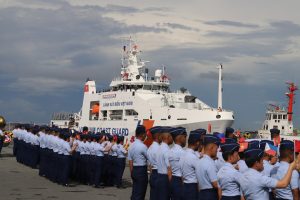On August 9, the Philippines and Vietnam held the first maritime security exercises between their respective coast guards. The drills mark a new chapter in the history of their bilateral relations, with a memorandum of understanding (MOU) signed earlier this January opening up new avenues to enhance cooperation on maritime security. Beneath the veneer of this achievement, however, Hanoi and Manila have not always seen eye-to-eye in terms of foreign policy.
The Philippines and Vietnam have had a complicated relationship over the South China Sea. As Southeast Asia’s leading parties in the disputed Spratly Islands, their overlapping territorial claims have been a source of friction since the early days of the Benigno Aquino III administration. Vietnamese fishermen have and continue to engage in illegal, unreported, and unregulated fishing (IUUF) within the Philippines’ exclusive economic zone, to the detriment of local fisherfolk.
At the same time, Hanoi has taken a page from Beijing’s playbook and established a permanent presence in the Spratlys through its own artificial island-building activities. In fact, a June 7 report from the Center for Strategic and International Studies (CSIS) estimates Vietnam has reclaimed some 2,360 acres in the South China Sea – nearly half China’s 4,650 reclaimed acres.
It is interesting, then, that despite heightening tensions over the sea row, the Philippines has remained uncharacteristically silent about Vietnam’s activities. Manila had earlier embarked on an “assertive transparency” campaign to illuminate Beijing’s gray zone tactics by publicizing untoward incidents in the South China Sea. The goal was to raise public awareness and ensure it translates to domestic and international support for the Philippine position.
This was not the case for Vietnam. Philippine authorities and media outlets alike have made little mention of Vietnam’s military installations in the Spratlys, or its encroachment on traditional Filipino fishing grounds. This was further complicated by the fact that, despite their policy differences, Beijing and Hanoi have maintained a relatively close bilateral relationship. In fact, just days after the announcement of the August 9 drills with the Philippines, a Vietnamese frigate docked in Guangdong, China, for a five-day visit to “improve mutual understanding and trust” between the two countries.
This delicate balancing act did lead to some concessions from Beijing. Compared to the Philippines, China has refrained from applying similar pressure on Vietnam in the disputed territories. Speaking in front of the Philippines’ House Committee on National Defense and Security and the Special Committee on the West Philippine Sea last May, local fisherfolk claimed that Chinese vessels largely ignore the presence of Vietnamese fishing boats in Scarborough Shoal. Similarly, China has done little to prevent Hanoi’s reclamation activities in the South China Sea despite the rapid expansion in operations.
But while Vietnam continues to profess neutrality under its “Four Noes” defense policy, its burgeoning relationship with the Philippines shows that as far as Beijing is concerned, the Paracel and Spratly Islands are not open for negotiation. By hedging between China on one end and the Philippines and its allies on the other, Hanoi could maintain the upward trajectory of Sino-Vietnamese relations while simultaneously advancing its territorial and security interests in the South China Sea.
Manila, too, recognizes the value in strategically aligning its efforts in the South China Sea with Vietnam. “The enemy of my enemy is my friend,” or so the old saying goes. For his part, Philippine President Ferdinand Marcos Jr. has proven more than willing to accommodate Vietnamese territorial interests if it meant broadening his country’s network of allies in the region.
This is all the more important, considering the broader dynamics of Southeast Asia’s regional security architecture. Consensus and non-interference are some of the founding principles of the Association of Southeast Asian Nations (ASEAN). The ASEAN states do not typically meddle in each other’s affairs; and right now, none of the other claimants – Brunei, Indonesia, or Malaysia – are willing to rock the boat by taking a tougher stance against China.
Only Vietnam has proven itself as a viable partner for the Philippines in Southeast Asia, both in terms of the military capability and the political will to push back against Beijing’s activities in the South China Sea. When Manila filed a claim with the United Nations to an extended continental shelf (ECS) west of the Palawan region, Vietnam was one of the few ASEAN states to acknowledge its merits. Unlike Malaysia, which “categorically rejected” the submission over longstanding issues regarding the territory of Sabah, Hanoi remained open to discussing its overlapping claims with Manila in order to find a suitable compromise. In fact, Vietnam went on to file a similar claim to the U.N. just a month later.
The fact is that the Marcos Jr. administration never really had a problem with generating support from extra-regional actors. Between the U.N. Convention on the Law of the Sea and its 2016 arbitral victory, defenders of the rules-based order have rarely ever shied away from expressing support to Manila’s legal position on the South China Sea. The challenge these days is generating that same amount of support while balancing competing interests within the consensus-based politics of the ASEAN region.
Partnering up with Vietnam would allow the Philippines to increase the legitimacy of its claim while still putting primacy on ASEAN centrality. It dispels allegations that the Philippines is beholden to U.S. interests and is actively working to internationalize the disputes and destabilize the region. At the same time, it shows Manila’s willingness to accommodate ASEAN sensibilities by keeping the disputes as a regional issue and actively working toward an acceptable resolution alongside a fellow claimant.
With the groundwork for further cooperation already in place, the Philippines would do well to capitalize on last Friday’s exercises and explore other areas of mutual interest with the Vietnamese. Right now, working toward a joint submission to the U.N. to recognize their ECS seems the logical conclusion for Hanoi and Manila if they are hoping to cement this burgeoning new partnership.

































